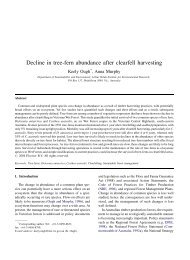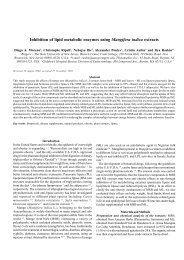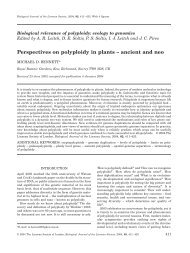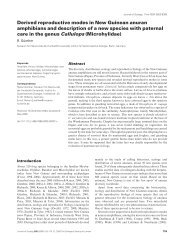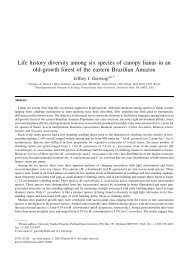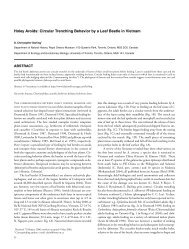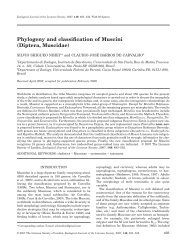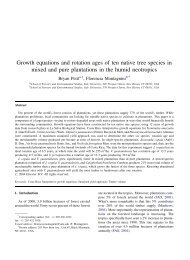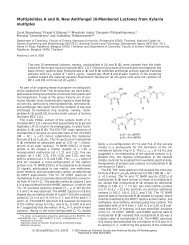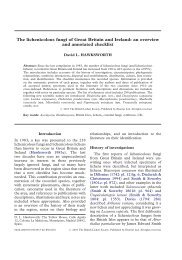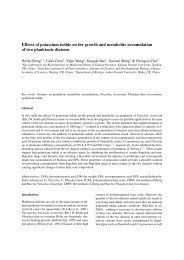Frequency of Cyanogenesis in Tropical Rainforests of Far North ...
Frequency of Cyanogenesis in Tropical Rainforests of Far North ...
Frequency of Cyanogenesis in Tropical Rainforests of Far North ...
You also want an ePaper? Increase the reach of your titles
YUMPU automatically turns print PDFs into web optimized ePapers that Google loves.
the field early last century, report<strong>in</strong>g a number <strong>of</strong><br />
cyanogenic species and the specific cyanogenic constituents<br />
<strong>in</strong>volved (e.g. Petrie, 1912, 1913, 1914, 1920;<br />
F<strong>in</strong>nemore and Cox, 1928, 1929; F<strong>in</strong>nemore and<br />
Cooper, 1936, 1938). More than 700 species <strong>in</strong> the<br />
Queensland flora were screened by Smith and White<br />
(1918). Further phytochemical screen<strong>in</strong>g <strong>of</strong> the Queensland<br />
flora was conducted by Webb (1948, 1949); however, there<br />
was negligible test<strong>in</strong>g among tropical taxa. Importantly,<br />
many <strong>of</strong> these records are based on qualitative tests performed<br />
us<strong>in</strong>g herbarium specimens, and tests <strong>of</strong> this k<strong>in</strong>d<br />
us<strong>in</strong>g dried material are by no means conclusive. One further<br />
limitation <strong>of</strong> these data <strong>in</strong> terms <strong>of</strong> extrapolat<strong>in</strong>g to<br />
natural plant communities is that negative results were<br />
<strong>of</strong>ten not reported.<br />
<strong>Tropical</strong> ra<strong>in</strong>forests are <strong>of</strong> particular <strong>in</strong>terest <strong>in</strong> the<br />
study <strong>of</strong> plant chemical defences. Elevated herbivore pressure<br />
<strong>in</strong> tropical environments is hypothesized to have<br />
favoured both a diverse array <strong>of</strong> defences and high levels<br />
<strong>of</strong> <strong>in</strong>vestment <strong>in</strong> chemical defence (Lev<strong>in</strong>, 1976; Lev<strong>in</strong> and<br />
York, 1978; Coley and Barone, 1996; Kursar and Coley,<br />
2003). Indeed, <strong>in</strong> the field <strong>of</strong> plant secondary chemistry, the<br />
tropical ra<strong>in</strong>forest has been the focus <strong>of</strong> <strong>in</strong>tense <strong>in</strong>terest<br />
<strong>in</strong> co-evolutionary relationships between plants and<br />
herbivores, and the extraord<strong>in</strong>ary <strong>in</strong>ter-specific and <strong>in</strong>traplant<br />
variation <strong>in</strong> chemical defence strategies (Feeny,<br />
1976; Lev<strong>in</strong>, 1976; Coley et al., 1985; Coley and<br />
Kursar, 1996).<br />
On the whole, community-level studies <strong>of</strong> the distribution<br />
<strong>of</strong> chemical defences have focused on a small set <strong>of</strong> Asian<br />
and African ra<strong>in</strong>forests (McKey et al., 1978; Gartlan et al.,<br />
1980; Davies et al., 1988; Waterman et al., 1988). In<br />
addition, these and other studies have tended to focus on<br />
C-based ‘quantitative’ defences (e.g. Coley, 1983, 1988).<br />
Among N-based defences, the greater awareness <strong>of</strong> the<br />
frequency <strong>of</strong> alkaloid-bear<strong>in</strong>g plants <strong>in</strong> tropical and other<br />
ecosystems is a consequence <strong>of</strong> extensive phytochemical<br />
screen<strong>in</strong>g for bioactive compounds (e.g. Swanholm et al.,<br />
1960; Hartley et al., 1973; Smolenski et al., 1974; Coll<strong>in</strong>s<br />
et al., 1990; Hadi and Bremmer, 2001) or ecological<br />
research <strong>in</strong>to specific plant–herbivore <strong>in</strong>teractions (e.g.<br />
Janzen and Waterman, 1984; Hartmann et al., 1997), rather<br />
than systematic studies with<strong>in</strong> natural communities (but<br />
see Mali and Borges, 2003).<br />
There are some hypothesis-driven surveys for cyanogenesis.<br />
Two studies have <strong>in</strong>vestigated the frequency <strong>of</strong> cyanogenesis<br />
<strong>in</strong> floras, <strong>in</strong>vestigat<strong>in</strong>g evolutionary and ecological<br />
hypotheses about exposure to herbivory (see Kaplan et al.,<br />
1983; Adsersen et al., 1988; Adsersen and Adsersen, 1993).<br />
However, only the survey <strong>of</strong> Thomsen and Brimer (1997) <strong>in</strong><br />
Costa Rican ra<strong>in</strong>forest has been conducted <strong>in</strong> a systematic<br />
fashion, well def<strong>in</strong>ed with respect to forest area and plant<br />
size. As with other N-based defences, work on cyanogenic<br />
tropical ra<strong>in</strong>forest species worldwide is limited, and<br />
there has been no work on cyanogenesis <strong>in</strong> Australian tropical<br />
ra<strong>in</strong>forests, or any other form <strong>of</strong> chemical defence. The<br />
lack <strong>of</strong> work on cyanogenesis <strong>in</strong> diverse tropical ra<strong>in</strong>forests<br />
is further surpris<strong>in</strong>g, as it is a readily detectable and constitutive<br />
chemical defence (Gleadow and Woodrow,<br />
2000b).<br />
Here we report some <strong>of</strong> the f<strong>in</strong>d<strong>in</strong>gs <strong>of</strong> a large-scale<br />
quantitative survey for cyanogenesis <strong>in</strong> Australian tropical<br />
ra<strong>in</strong>forests. First, we <strong>in</strong>vestigated the frequency <strong>of</strong> cyanogenesis<br />
and the contribution <strong>of</strong> cyanogenic species to<br />
biomass (basal area) <strong>in</strong> lowland, upland and highland tropical<br />
ra<strong>in</strong>forest <strong>in</strong> north Queensland, Australia. Conduct<strong>in</strong>g<br />
the survey <strong>in</strong> a standardized fashion will enable comparison<br />
with other communities (e.g. Thomsen and Brimer, 1997).<br />
Secondly, <strong>in</strong>tra-plant and <strong>in</strong>tra-population variation <strong>in</strong> concentrations<br />
<strong>of</strong> cyanogenic glycosides was quantified. The<br />
high level <strong>of</strong> endemism among the Australian tropical ra<strong>in</strong>forest<br />
flora (Webb and Tracey, 1981) and the number <strong>of</strong><br />
ra<strong>in</strong>forest taxa previously untested for cyanogenesis underscore<br />
the potential for novel reports <strong>of</strong> cyanogenesis with<strong>in</strong><br />
different taxonomic groups. F<strong>in</strong>ally, therefore, this study<br />
aimed to <strong>in</strong>vestigate the potential taxonomic significance<br />
<strong>of</strong> cyanogenesis reported here. Overall, this study aimed<br />
to expand the limited knowledge <strong>of</strong> the frequency <strong>of</strong><br />
cyanogenesis <strong>in</strong> the Australian flora and <strong>in</strong> natural plant<br />
communities.<br />
MATERIALS AND METHODS<br />
Field sites<br />
Field work was conducted between July 1999 and<br />
September 2002. Six 200 m 2 plots (20 · 10 m) were established<br />
at each <strong>of</strong> five sites (total area 1200 m 2 per site) <strong>in</strong><br />
lowland and upland ra<strong>in</strong>forest <strong>in</strong> the tropics <strong>of</strong> north east<br />
Queensland, Australia (Fig. 1). Six plots were selected for<br />
two reasons: first, the number <strong>of</strong> new species captured with<br />
each additional plot had reached a plateau at around five<br />
species and, secondly, it was a realistic sample size given<br />
the time and resources available. Sites were selected to<br />
capture maximum species diversity as on the Atherton<br />
Tablelands, forest type and species composition vary<br />
both with substrate and with altitude (Tracey, 1982). Further,<br />
to enable comparison <strong>of</strong> forests occurr<strong>in</strong>g on different<br />
soil types, two pairs <strong>of</strong> sites with similar altitude and ra<strong>in</strong>fall<br />
were selected. The first pair comprised a site on soil derived<br />
from basalt at Lam<strong>in</strong>s Hill and one on soil derived from<br />
granite at Mt Nomico (Fig. 1). The second pair comprised<br />
sites on soils derived from basalt and rhyolite at Longlands<br />
Gap (Fig. 1). A fifth site <strong>in</strong> lowland ra<strong>in</strong>forest near<br />
Cape Tribulation and Myall Creek, on soil derived<br />
from metamorphic substrate, was also surveyed (Fig. 1).<br />
The distribution <strong>of</strong> cyanogenic species <strong>in</strong> relation to<br />
resource availability (soil nutrients) will be addressed<br />
elsewhere (see Miller, 2004).<br />
It was not possible to control strictly for logg<strong>in</strong>g history;<br />
all sites on the Atherton Tablelands had been selectively<br />
logged prior to the declaration <strong>of</strong> the Wet Tropics World<br />
Heritage Area <strong>in</strong> 1988. Detailed site descriptions are provided<br />
<strong>in</strong> Miller (2004).<br />
All <strong>in</strong>dividuals (palms, trees and v<strong>in</strong>es) with a diameter at<br />
breast height (dbh) <strong>of</strong> >5 cm were tagged and identified.<br />
All additional species (dbh




